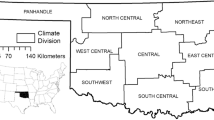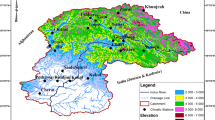Abstract
Most montane and alpine ecosystem climate change studies have focused on changes in biota; few report temperature changes from several stations. This study reports temperature changes in the San Luis Valley (SLV) based on climate station data from a 113-year period. The SLV is a high sub-alpine desert, and the local community relies heavily upon the local irrigated agriculture for its livelihood. Because of the importance of agriculture to the local community and the effects climate change may have on agriculture, this study investigates differences in annual and growing season temperatures. Data from seven climate stations on the floor of the SLV were obtained from the National Climate Data Center, adjusted for inhomogeneities and reconstructed—where necessary—from 1895 to 2008. Change point analysis was employed to identify distinct periods of different mean temperatures values. Change point analysis identified 1993–1994 as the change point in mean annual temperature. Maximum, minimum, and mean annual temperature for each period, 1895–1993 and 1994–2008, were then compared using a one-tailed General Linear Model to determine the presence of significant increases in mean temperature values, which indicated an approximate increase in annual mean temperature of 1°C and growing season temperature increase of 0.65°C, after 1993. The temperature changes reported here do not correspond to the events related to PDO, ENSO, or NAO. No local land use changes could be attributed to the temperature increases or the latent response to global changes, either. Therefore, since the temperature change occurred 15–20 years after the typically reported 1976 beginning of increases in global mean temperature, we conclude the changes to be an artifact of the local topography and result from global temperature change, similar to the few other high-elevation temperature studies.






Similar content being viewed by others
References
Allen, M. R., & S. F. B. Tett. (1999). Checking for model consistency in optimal finger printing. Climate Dyn., 15, 419–434.
Bǎrbulescu, A., & Bǎutu, E. (2009). Mathematical models of climate evolution in Dobrudja. Theoretical and Applied Climatology. doi:10.1007/s00704-009-0160-7.
Beniston, M., & Rebetez, M. (1996). Regional behavior of minimum temperatures in Switzerland for the period 1979–1993. Theoretical and Applied Climatology, 53, 231–243.
Bloomfield, P. (1992). Trends in global temperature. Climatic Change, 21, 1–16.
Braganza, K., Karoly, D. J., & Arblaster, J. M. (2004). Diurnal temperature range as an index of global climate change during the Twentieth Century. Geophysical Research Letters, 31, L13217–L13220.
Breazeale, D., Kettle, R., & Munk, G. (2008) Fact Sheet 99-71. http://www.unce.unr.edu/publications/files/ag/other/fs9971.pdf. Last accessed 6/24/2008.
Brown, J. L., Shou-Hsien, L., & Bhagabati, N. (1999). Long-term trend toward earlier breeding in an American bird: A response to global warming? Proceedings of the National Academy of Science, 96, 5565–5569.
Buishand, T. A. (1981). The analysis of homogeneity of long-term rainfall records in the Netherlands. K.N.M.I. Scientific report 81-7, The Netherlands, 42 p.
Cassidy, M., Mazzone, P., Oliviero, A., Insola, A., Tonali, P., Di Lazzaro, V., et al. (2002). Movement-related changes in synchronization in the human basal ganglia. Brain, 125, 1235–1246.
Craddock, J. M. (1979). Methods of comparing annual rainfall records for climatic purposes. Weather, 34, 332–346.
CSU. Colorado State University Cooperative Extension – San Luis Valley Research Center. (2003a). San Luis Valley crop statistics summary. http://www.colostate.edu/Depts/SLVRC/CROPWATER/lifeblood07.pdf. Last accessed 12/18/2009.
CSU. Colorado State University Cooperative Extension – San Luis Valley Research Center. (2003b). Agriculture: Lifeblood of the San Luis Valley. http://www.colostate.edu/Depts/SLVRC/CROPWATER/2002lifeblood.pdf. Last accessed 12/18/2009.
Davenport, D. C., & Hudson, J. P. (1967). Meteorological observations and Penman estimates along a 17 km transect in the Sudan Gezira. Agr Meteor., 4, 405–414.
Derscheid, L., & Lytle, W. (1981). (pdf 2002) http://sdces.sdstate.edu/ces_website/hit_counter.cfm?item=FS522&id=607. Last accessed 6/24/2008.
Dettinger, M. D., & Cayan, D. R. (1995). Large-scale atmospheric forcing of recent trends toward early snowmelt runoff in California. Journal of Climate, 8, 606–623.
de Vries, D. A., & Birch, J. W. (1961). The modification of climate near the ground by irrigation for pastures on the Riverine plain. Aust. J. Agr. Res., 12, 260–272.
Diaz, H. F., & Bradley, R. S. (1997). Temperature variations during the last century at high elevation sites. Climatic Change, 36, 253–279.
Dzerdzeevskii, B. L. (1963). Meteorological parameters of the surface air layer over humid and dry sectors of the Trans-Volga Steppe. In B. L. Dzerdzeevskii (Ed.), Sukhoveis and drought control (pp. 162–180). Jerusalem: Israel Program for Scientific Translations.
Enfield, D. B., Mestas-Nuñez, A. M., & Trimble, P. J. (2001). The Atlantic multidecadal oscillation and its relation to rainfall and river flows in the continental U.S. Geophysical Research Letters, 28, 2077–2080.
Fischer, G., Frohberg, K., Parry, M. L., & Rosenzweig, C. (1996). In F. Bazzaz & W. Sombroek (Eds.), The potential effects of climate change on world food production and security in global climate change and agricultural production. Direct and indirect effects of changing hydrological, pedological and plant physiological processes. Chichester: Food and Agriculture Organization of the United Nations and John Wiley & Sons.
Folland, C. K., Rayner, N. A., Brown, S. J., Smith, T. M., Shen, S. S. P., Parker, D. E., et al. (2001). Global temperature change and its uncertainties since 1861. Geophysical Research Letters, 28, 2621–2624.
Finnerty, B., & Ramirez, J. A. (1995). Impact assessment study of climate change on evapotranspiration and irrigated agriculture in the San Luis Valley, Colorado. AWRA 31st Annual Conference and Symposia, Houston, TX.
Haeberli, W., & Beniston, M. (1998). Climate change and its impacts on glaciers and permafrost in the Alps. Ambio, 27, 258–265.
Hansen, J., Makiko, S., Reto, R., Lo, K., Lea, D. W., & Medina-Elizade, M. (2006). Global temperature change. Proceedings of the National Academy of Science, 103, 14288–14293.
Hartz, T. K., & Moore, F. D. (1978). Prediction of potato yield using temperature and insolation data. Amer. J. Potato Res., 55, 431–436.
Herrington, P. (1996). Climate change and the demand for water (p. 164). London: HMSO.
IPCC. (2001). In J. T. Houghton, Y. Ding, D. J. Griggs, M. Noguer, P. J. van der Linden, X. Dai, K. Maskell, & C. A. Johnson (Eds.), Climate change 2001: the scientific basis. Contribution of working group I to the third assessment report of the Intergovernmental Panel on Climate Change (p. 881). Cambridge: Cambridge University Press.
IPCC. (2007). In R. K. Pachauri & A. Reisinger (Eds.), Climate change 2007: synthesis report. Contribution of working groups I, II and III to the fourth assessment report of the Intergovernmental Panel on Climate Change (p. 104). Geneva: IPCC.
Karl, T. R., Jones, P. D., Knight, R. W., Kukla, G., Plummer, N., Razuvayev, V., et al. (1993). A new perspective on recent global warming: asymmetric trends of daily maximum and minimum temperature. Bull. Amer. Meteor. Soc., 74, 1007–1034.
King, G. (2007). The hottest and coldest places in the conterminous United States. Yearbook Assoc. Pacific Coast Geograph, 69, 101–114.
Liu, X., & Chen, B. (2000). Climatic warming in the Tibetan plateau during recent decades. Internatl. J. Climatol., 20, 1729–1742.
Luckman, B., & Kavanagh, T. (2000). Impact of climate fluctuations on mountain environments in the Canadian Rockies. Ambio, 29, 371–380.
Mantua, N. J., & Hare, S. R. (2002). The pacific decadal oscillation. J. of Oceanography, 58, 35–44.
Marchenko, S. S., Gorbunov, A. P., & Romanovsky, V. E. (2007). Permafrost warming in the Tien Shan Mountains, Central Asia. Global and Planetary Change, 56, 311–327.
McCarty, J. P. (2001). Ecological consequences of recent climate change. Conservation Biology, 15, 320–331.
Menne, M. J., & Williams, C. N. (2009). Homogenization of temperature series via pairwise comparisons. Journal of Climate, 22, 1700–1717.
Mix, K., Rast, W., & Lopes, V. L. (2010). Increases in annual and growing season growing degree days in the alpine desert of the San Luis Valley, Colorado. J. Water, Air and Soil Poll, 205, 289–304. doi:10.1007/s11270-009-0074-0.
Ogburn, R. W. (1996). A history of the development of San Luis Valley Water. The San Luis Valley Historian, 28, 5–40.
Ozenda, P., & Borel, J.-L. (1991). Mögliche ökologische Auswirkungen von Klimaveränderungen in den Alpen. Schaan: Internationale Alpenschutz-Kommission CIPRA. Kleine Schriften, 71 pp.
Page, E. S. (1955). A test for a change in a parameter occurring at an unknown point. Biometrika, 42, 523–527.
Page, E. S. (1957). On problems in which a change in a parameter occurs at an unknown point. Biometrika, 44, 248–252.
Parmesan, C. (2006). Ecological and evolutionary responses to recent climate change. Ann. Rev. Ecol., Evol. and Systematics, 37, 637–669.
Pauli, H., Gottfried, M., & Grabherr, G. (1996). Effects of climate change on mountain ecosystems - upward shifting of alpine plants. World Resources Review, 8, 382–390.
Pettitt, A. N. (1979). A non-parametric approach to the change-point problem. Appl. Statistics, 28, 126–135.
Post, E. S., Pedersen, C., Wilmers, C. C., & Forchhammer, M. C. (2008). Phenological sequences reveal aggregate life history response to climatic warming. Ecology, 89, 363–370. doi:10.1890/06-2138.1.
Quinn, W. H., Neal, V. T., & de Mayolo, S. E. A. (1987). El Nino occurrences over the past four and a half centuries. J. of Geophys. Res. C. Oceans., 92, 14449–14461.
Rebetez, M., & Dobbertin, M. (2004). Climate change may already threaten Scots pine stands in the Swiss Alps. Theoretical and Applied Climatology, 79, 1–9.
Salinger, M. J., & Mullan, A. B. (1999). New Zealand climate: temperature and precipitation variations and their links with atmospheric circulation 1930–1994. Internatl. J. Climatol., 19, 1049–1071.
Segal, M., Avissar, R., McCumber, M., & Pielke, R. (1988). Evaluation of vegetation effects on the generation and modification of mesoscale circulations. Journal of Atmospheric Sciences, 45, 2268–2293.
Sexton, D. M. H., Grubb, H., Shine, K. P., & Folland, C. K. (2003). Design and analysis of climate model experiments for the efficient estimation of anthropogenic signals. Journal of Climate, 16, 1320–1336.
SLVDRG. (2002) Comprehensive development strategy (CEDS). http://www.slvdrg.org/ceds_historic.php. Last accessed 7/25/2009.
Sombroek, W. G., & Gommes, R. (1996). In F. Bazzaz & W. Sombroek (Eds.), The climate change—agriculture conundrum in global climate change and agricultural production. Direct and indirect effects of changing hydrological, pedological and plant physiological processes. Chichester: Food and Agriculture Organization of the United Nations and John Wiley & Sons.
Taylor Enterprizes. (2008) http://www.variation.com/cpa/tech/changepoint.html. Last accessed 6/15/2008.
Vuille, M., & Bradley, R. S. (2000). Mean annual temperature trends and their vertical structure in the tropical Andes. Geophysical Research Letters, 27, 3885–3888.
Walther, G.-R., Post, E., Convey, P., Menzel, A., Parmesan, C., Beebee, T. J. C., et al. (2002). Ecological responses to recent climate change. Nature, 416, 389–395.
Weber, R. O., Talkner, P., & Stefanicki, G. (1994). Asymmetric diurnal temperature change in the Alpine region. Geophysical Research Letters, 21, 673–676.
Winkler, D. W., Dunn, P. O., & McCulloch, C. E. (2002). Predicting the effects of climate change on avian life-history traits. Proceedings of the National Academy of Science, 99, 13595–13599.
Zanchettin, D., Traverso, P., & Tomasino, M. (2008). Po River discharges: a preliminary analysis of a 200-year time series. Climatic Change, 89, 411–433.
Author information
Authors and Affiliations
Corresponding author
Rights and permissions
About this article
Cite this article
Mix, K., Lopes, V.L. & Rast, W. Annual and Growing Season Temperature Changes in the San Luis Valley, Colorado. Water Air Soil Pollut 220, 189–203 (2011). https://doi.org/10.1007/s11270-011-0746-4
Received:
Accepted:
Published:
Issue Date:
DOI: https://doi.org/10.1007/s11270-011-0746-4




